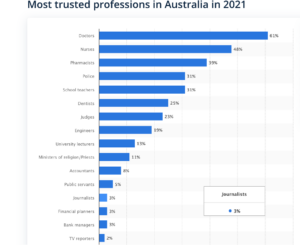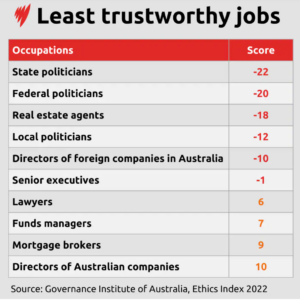Time for a quick pop quiz.
Hands up if you thought Stolichnaya vodka was made in Russia.
Keep it up if you stopped buying Stoli after the Russia/Ukraine conflict started.
If you are one of the majority who I suspect still have their hands in the air, then I have news for you!
Stoli vodka (as it has been rebranded since 2022) – at least the version drunk in most countries around the world – is actually made in Latvia (check for yourself). So swapping brands in this context seems a little misguided. (As a side note, Russian vodka isn’t as the dominant force we may think. In 2021 for example, before the Ukraine conflict even began, it accounted for only 1.3% of total vodka imports into the US.)

If you are wondering the relevance of this collection of fun(nish) facts, it’s a handy lead in for me to talk about trust. Trust in brands. Which according to countless textbooks and many marketing gurus is the holy grail of brand metrics. But which according to the always erudite Professor Mark Ritson, is hokum.
The research into trust is plentiful
If we jump in the helicopter to get a birds-eye view, our attention will inevitably be drawn to some of the mainstays of the trust research landscape. One of the biggest is the Edelman Trust Barometer, which has been tracking consumer trust levels for more than two decades.
The 2024 edition of the Barometer was published recently, and makes for some interesting reading, with findings that will undoubtedly raise a few eyebrows.
Among the headlines are these fun facts:
- The governments most trusted by their own citizens can be found in China, Saudi Arabia, the UAE, and Indonesia
- Those least trusted by their own citizens can be found in Japan, South Korea, and the UK
- Australians are ‘neutral’ towards their own government
- In terms of sectors, Australians actively distrust the media (and journalists) and politicians, while they are neutral towards businesses
- When it comes to business sectors, the most distrusted are social media (by a big margin), followed by energy, financial services, and fashion
- Gen Z generally don’t trust anything.
When we’ve done browsing through all the Edelman data, our attention might then get drawn to the many lists that get published ranking the most and least trusted professions and industries.
Who we trust (and who we don’t)
Such lists are always newsworthy, and perhaps unsurprisingly the rankings are generally pretty similar around the world, with healthcare professionals, teachers, and engineers somewhere around the top, and lawyers, politicians, journalists, and financial planners close to the bottom.
Actually at the very bottom, and not shown below, are used cars salespeople, real estate agents, stockbrokers, and people who work in advertising!).

Source: Statista
Fund Managers didn’t escape either, at least not in the eyes of the Governance Institute of Australia and their 2022 Ethics index.

But back to brands
Pop ‘brand trust’ into Google, and you will literally get over 1 billion results. Many of the top results spruik what we see as the orthodoxy in brand trust thinking – that trust in brands is positively associated with the financial performance of those brands.
Forbes for example, reports that trusted companies outperform their peers by up to 400%, directly correlating with the bottom line. Customers who trust a brand are 88% more likely to buy again. And 79% of employees who trust their employers are more motivated to work and less likely to leave.
Which all sounds like common sense.
But consider the counter argument to this, put forward by high profile – and often controversial – marketing expert Mark Ritson.
As he puts it, brands aren’t like people. You don’t need to trust them to prefer and purchase from them. Optus and Telstra, Qantas, the big banks, the Australian corporate landscape is full of brands who lurk around the top of Roy Morgan’s league table of the most distrusted brands, and yet – financially at least – seem to go from strength to strength. Sure, Optus may have taken a hit after its infamous national outage, but that’s arguably to do with a more functional assessment of their ability to keep your wifi working than because they’ve inherently ‘lost your trust’.
Internationally we see similar results, with Amazon and Tik Tok making that same league of infamy, and yet remaining powerhouse brands.

Source: Roy Morgan
The way Ritson sees it, while losing trust is not a desired outcome, it’s also not the brand-killing issue many portray it to be (just ask VW). He also reckons what truly drives brand profitability is awareness.
There’s plenty of backers in Ritson’s corner, too.
Research by Australian data consultancy 5D found that 1 in 5 non-consumers who have a brand they prefer to all others claim they do not actually trust that brand – while of the brands most likely to never be considered 1 in 5 was highly trusted.
Further, they found 70% of customers who distrust the brand they are with say they plan to either maintain or increase the number of products they have with that brand.
Even Edelman (them again!) found that only one-third of consumers (34 percent) trust most of the brands they buy or use.
Go figure!
Who do financial advisors trust?
The power of influence has a huge impact on the choices we make and how we live our lives. More than ever before, we make decisions based on the views and recommendations of our peers. These are the people we trust, the ones who have ‘been there and done that.
There is no bigger example of this than the popularity of peer review sites such as Google Reviews, Trust Pilot, and Trip Advisor. If we are planning to buy a car, book a holiday, or visit a restaurant, we don’t trust the glossy brochures and the PR spin. We trust average people who have spent their own money buying and doing these things themselves. People who probably care about the little things and talk our language – rather than corporate ‘doublespeak’.
Financial advisors are no different. Every day they are making decisions about products to recommend and services to buy. They are solving problems – either their own, or those of their clients – and they are being asked questions, which they don’t always have the answers to. And where they look for those answers is their professional peers.
As the AFSL landscape has fragmented, findings peers to talk to has become more challenging for those in smaller practices. Which is why the Ensombl platform has gone from strength to strength. With over 8,500 users (and growing), it has become the number one platform for advisors to pose, and answer questions. It’s become the place where advisors go to collaborate and share, and help each other with everything from interpreting legislation to choosing technology.
The great news for brands wanting to talk to advisors is that you will find them a willing audience – provided you can solve their challenges.
And that’s where we come in; working with our corporate partners to design content programs that are effectively co-created with our users, meaning they are jam packed with advisor insights.
The trust dividend we see in this approach is plain for all to see. Co-created content achieves higher responsiveness of around 45% compared to standard corporate content.
And that’s a result you can trust.
To find out more about how to leverage this trust dividend with advisors, get in touch, we’d love to show you more.

